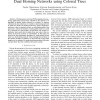Free Online Productivity Tools
i2Speak
i2Symbol
i2OCR
iTex2Img
iWeb2Print
iWeb2Shot
i2Type
iPdf2Split
iPdf2Merge
i2Bopomofo
i2Arabic
i2Style
i2Image
i2PDF
iLatex2Rtf
Sci2ools
GLOBECOM
2006
IEEE
2006
IEEE
Disjoint Multipath Routing in Dual Homing Networks using Colored Trees
Abstract— Wireless sensor networks (WSNs) employed in monitoring applications require data collected by the sensors to be deposited at specific nodes, referred to as drains. To improve robustness in data collection, we consider a dual homing network in which two drains are employed and every node is required to send data to the two drains over link- or node-disjoint paths. One approach to reduce the number of routing table entries at a node is to construct two trees, namely red and blue, each rooted at a particular drain such that the paths from any node to the two drains on the trees are link- or node-disjoint. In this paper, we develop the first distributed algorithm for constructing colored trees in a dual-homing network whose running time is linear in the number of links. In addition, we show that the average path length may be optimized by employing the generalized low-point concept rather than the traditional low-point concept.
| Added | 11 Jun 2010 |
| Updated | 11 Jun 2010 |
| Type | Conference |
| Year | 2006 |
| Where | GLOBECOM |
| Authors | Preetha Thulasiraman, Srinivasan Ramasubramanian, Marwan Krunz |
Comments (0)

